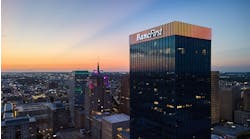Tenant amenities are more important than ever in the effort to bring employees back to office spaces. Driven by requests from tenants, owners are looking for opportunities to strategically upgrade office buildings in ways that will drive foot traffic.
“Different tenants are asking for different amenities, but the common thread is that they want their employees surprised by how robust the amenity package is,” explained Grant Bollman, senior associate at Lee & Associates of Illinois, a commercial real estate services provider. “Current tenant demand is for more bells and whistles so they can tell their employees, ‘Come into the office. Before, we had a gym and a shared conference room, but now we have X, Y and Z.’”
Tenants who elect to come back into the office need to have a good reason for doing so, added Sarah Brooks, senior associate with GTM Architects and the primary designer on Washington, DC’s 1750 H Street, a recently renovated 10-story office building that now has several new amenity spaces. Since the emergence of COVID-19, people have realized they can work nearly anywhere, so they consider other factors when they choose to commute to your building.
“The No. 1 thing we think about is, how do we make this more of a seamless transition of working in the office as opposed to working at home?” Brooks said. “People have things at their fingertips when they work from home. We want to provide that when you go into an office building—where you have that same flexibility and multiple levels of privacy.”
The amenity conversation in 2024 harkens back to the urban planning theory of 15-minute cities, said Ann Hoffman, director of workplace strategy for FCA. This architecture firm recently designed its own Philadelphia headquarters, including several amenities. “You’re 15 minutes from everything that’s important to you—the bank, the post office, the school, the church, groceries, art museums, parks,” explained Hoffman. “As much of that as you can pull into the microcosm of the building itself, you’re creating your own little city. It’s convenience close by.”
These five amenity ideas have proved popular in recent years. Could one of them be a fit for your building?
1. Pickleball Courts
Pickleball—a fast-paced, but easy-to-learn sport—is taking off across America. Played on a court the same size as a doubles badminton court, it resembles tennis or table tennis, but with different rules. Tenants may not specifically seek out pickleball courts, but they’re a definite nice-to-have that can help differentiate buildings in the marketplace, Bollman said.
“Pickleball is really hot now,” added Tiffany Hughes, senior project interior designer for FCA. The building housing FCA’s offices has a multipurpose outdoor space that sometimes hosts pickleball matches. “There was, frankly, an underutilized outdoor courtyard directly off of what used to be the conference center. Now that it’s accessed by the gym, directly off the fitness center, you can go outside and do yoga, have outdoor classes or do pickleball lessons.”
2. Gyms and Health Services
A space for people to work out is a major attraction. It saves people the time they’d otherwise spend going to an off-site gym on their way to or from the office. Looking to improve an existing gym? Consider expanding with sports areas, Bollman suggested.
“The upper echelon of a gym would be what someone might call a health club,” Bollman said. “Maybe there’s squash included or a half basketball court. Maybe the towel service is factored into the cost of being in the building, or they have a turf area for training. Those are some of the things where tenants are saying, ‘I want an area for my employees to work out, but you’re not just checking a box. You’re going above and beyond to make it really special.’”
Wellness amenities don’t stop at workout spaces, Hughes added. Doctor’s offices and small urgent care clinics are an up-and-coming addition to office buildings.
“It’s about convenience,” Hughes said. “Everyone’s time is valuable.”
3. Common Conference and Coworking Space
Office tenants are downsizing their footprints, and one of the first spaces to be cut is often large conference rooms. However, that can leave tenants in the lurch if they need to gather many employees together in a communal space. Building owners can meet that need with flexible conference space that can be checked out as needed.
Many clients are looking for conference rooms on the larger side, but with dividers that allow users to create smaller breakout rooms, Brooks said.
Different types of communal workspaces are also a popular amenity, Hughes added: “People are used to not being tethered to a desk. They’re working in their living rooms on lounge sofas, or they’re in their kitchens working on higher top tables and bar stools.”
Letting people choose where in the building to work also gives them a sense of autonomy. Adding more user control features, like dimmable task lighting or adjustable table heights, add to that feeling, Hoffman said. FCA uses workstations by Haworth and Teknion to give people adjustable spaces to work; they have access to power for device charging.
4. Outdoor Areas
Work and relaxation spaces on an outdoor terrace are a differentiator for buildings that have that option, Brooks said. Views of the outdoors can also enliven the indoors.
1750 H Street has a large conference room with a telescoping glass wall that opens up to a free-function lounge area; people in the lounge area also have an operable glass window that opens at a countertop to give the space an indoor-outdoor feel. “We also enlarged the terrace on that project to create more outdoor space,” Brooks added.
Another GTM Architects project at 2677 Prosperity Avenue in Fairfax, Virginia, features a 50-seat conference room adjoining an area with an operable glass storefront that opens to an outdoor patio.
5. Snacks and Food Options
Office workers have spent the last few years enjoying free reign over whatever snacks and drinks are available in their homes. Building owners can dominate the gourmet game by offering full-service snack bars, restaurants and a wide variety of beverages beyond what’s feasible for a work-from-home setup.
FCA’s redesigned Philadelphia headquarters has a smart beverage machine that provides cold and hot drinks, including seltzers. “The attempt was to provide all of those services that are built in—things you maybe wouldn’t have free access to in your home,” Hughes said. “We also wanted to reduce the plastics we have coming into the office—that was a big sticking point with our staff. We try to practice what we preach, and we feel strongly about sustainability.”
What Amenities are Best for Your Building?
The best amenity is the one that sets you apart from other similar buildings in your area, but there are other factors dictating the direction your building should go. Consider these six factors that can help you separate the must-haves from the nice-to-haves.
1. Cost. Not surprisingly, cost has the biggest impact on amenity space, Bollman said.
2. Rentable space. Every square foot you use for an amenity that the whole building can utilize is a square foot you can’t rent to a tenant. “Are you taking space that’s already set aside for amenities in your building to convert or change what the amenity is, or are you taking space that would otherwise be rentable and turning that into an amenity area?” Bollman asked.
3. Demographics. “If you’ve got a law firm, they have a certain type of client. Is it a corporate client or a personal injury client?” Hoffman said. “There’s an audience that comes in and out of the building. What are they going to be attracted to? Who are your tenants and what speaks to them?”
4. Location. “Location is huge,” Hoffman said. “We had a client whom we did a whole building for, and they put in a huge gym. The client owns the showers, the lockers and the gym. That’s a huge commitment, but it’s based on location—what’s near and what’s not. If there’s something not near, that’s the amenity you want.”
5. Rent. “Make sure your amenity package lines up with the price point you’re asking per square foot based on who your competitors are,” Bollman recommended. “If you’re a well-amenitized building, great—you can charge top-of-market rents, but the amenities need to be better than everybody else you’re competing with. If you’re not going to offer amenities, get that rate as low as you possibly can so there’s a clear delineation of what the tenant is going after.”
6. Staffing. Who is running your amenity? “Does it fall on the already put in place building management?” Hughes asked. “Do they have the capacity and the know-how to clean and run those types of spaces? If not, perhaps look to outsource to somebody who can run them properly, who can make sure they’re really up to snuff and able to track the metrics of what’s being used.”
Are Your Current Amenities Underutilized?
Is it time to remodel your current amenity spaces into something else? If no one is using the spaces you have now, the answer is almost certainly yes, said Brooks.
“They really need to be monitored,” Hughes added. “Somebody has to be watching the space or what’s within the space because you really want to grow with the times. If people are working differently, the space needs to be modified.”
Key card swipes are an easy way to track utilization, Bollman explained. Other strategies include monitoring the amount of supplies you have in spaces with consumables, such as a café or bar, or looking at how often spaces are booked if you have an online booking system. Not seeing enough swipes? Survey your tenants’ employees to find out what they want and what’s missing. “Concentrate on the amenities that tenants are now looking for,” Brooks said.
The right amenities placed in the right building will help attract tenants to your facility and employees to come back to your tenants’ offices. The convenience factor “allows people to take a break from what they’re doing and interact with their coworkers in a different way,” Bollman said.
“The office is not just for work,” he added. “It’s for life as well.”








